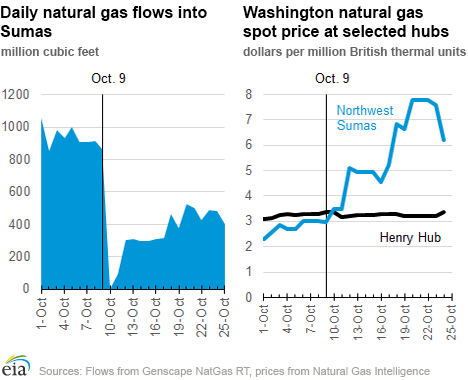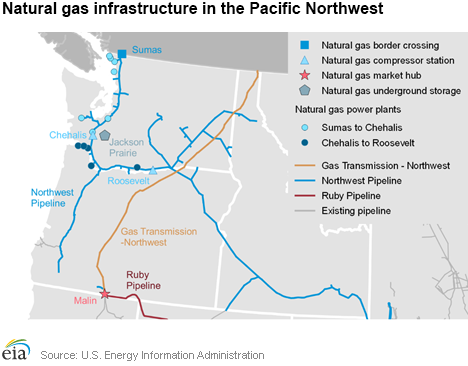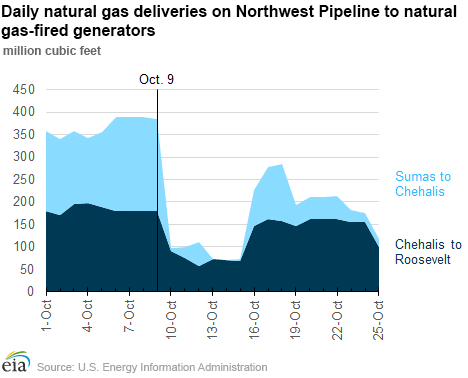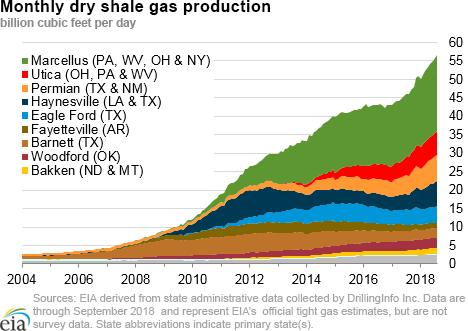In the News:
Pipeline explosion in Canada leads to lower U.S. natural gas imports, higher regional prices
A natural gas pipeline rupture on October 9, 2018, in British Columbia has resulted in a sharp decline in U.S. natural gas imports from Canada, causing higher prices in the Pacific Northwest and logistical challenges for the pipeline network in the region. U.S. imports of natural gas at Sumas, Washington, have averaged about 460 million cubic feet per day (MMcf/d) since October 18, according to data from Genscape. A week before the incident, U.S. imports at that location averaged about 930 MMcf/d. Spot natural gas prices at the Northwest Sumas (at the British Columbia-Washington border) trading hub, which were trading at a discount to Henry Hub before October 9, reached $7.79/MMBtu on Monday, October 22, $4.58/million British thermal units (MMBtu) higher than Henry Hub. Prices have since declined, closing yesterday (Wednesday, October 24) at $6.20/MMBtu, $2.85/MMBtu higher than the Henry Hub, according to Natural Gas Intelligence.
Enbridge’s Westcoast pipeline in Canada consists of two parallel lines (a 36-inch pipeline and a 30-inch pipeline) that can transport up to 1.7 billion cubic feet per day (Bcf/d) during winter months. Following the explosion on the 36-inch pipeline, flows from Canada into Sumas fell to zero as the adjacent 30-inch line was shut down and inspected. Pipeline operations resumed on October 11, and U.S. imports from Canada averaged 300 MMcf/d until higher pressures in the pipeline were approved on October 18, allowing imports to increase to their current levels. Enbridge announced that it expects repairs on the 36-inch line to be completed by mid-November and that the Westcoast pipeline system will operate at a reduced capacity of 0.9 to 1.3 Bcf/d throughout the winter.
Shifts in regional natural gas flows along the interstate natural gas pipeline system in the U.S. Pacific Northwest have made up for the shortfall in natural gas imports from Canada at Sumas. For example, the Northwest Pipeline (NWPL), which had been delivering natural gas for injection into the Jackson Prairie storage field in western Washington, was instead transporting natural gas withdrawn from storage northward toward the Seattle-Tacoma market in the days after the incident, according to NWPL’s informational postings. NWPL is also maximizing westward flows at the Roosevelt compressor station, which is centrally located on the Oregon-Washington border. On October 18, the company issued an Operational Flow Order and OFO Recall Advisory informing its shippers that the Roosevelt compressor station was operating at near-complete utilization (560 MMcf/d).
A similar shift has been observed on the 1.5 Bcf/d Ruby Pipeline (Ruby). On October 23, Ruby, which transports Rockies natural gas to western demand markets, flowed 1.25 Bcf/d of natural gas to the California-Oregon border at Malin―the highest flows reported on Ruby since November 2015.
Decreased deliveries of natural gas to power plants is another effect the limited natural gas supplies and higher prices have had on the region. Deliveries from NWPL to power plants west of the Roosevelt compressor station declined from 400 MMcf/d before the explosion to an average of 100 MMcf/d from October 10 to October 15, according to Genscape flow data. Since October 18, deliveries to these generators rose to 200 MMcf/d, but remain much lower than before the explosion. Power plants between the Sumas and Chehalis compressor stations in northwest Washington account for most of this difference because delivered volumes to power plants along that stretch of pipeline are only 25% of their pre-event levels.
Overview:
(For the Week Ending Wednesday, October 24, 2018)
- Natural gas spot prices rose at most locations this report week (Wednesday, October 17 to Wednesday, October 24). Henry Hub spot prices rose from $3.31 per million British thermal units (MMBtu) last Wednesday to $3.36/MMBtu yesterday.
- At the New York Mercantile Exchange (Nymex), the November 2018 contract price fell 15¢ from $3.320/MMBtu last Wednesday to $3.166/MMBtu yesterday.
- Net injections to working gas totaled 58 billion cubic feet (Bcf) for the week ending October 19. Working natural gas stocks are 3,095 Bcf, which is 16% lower than the year-ago level and 17% lower than the five-year (2013–17) average for this week.
- The natural gas plant liquids composite price at Mont Belvieu, Texas, fell by 61¢/MMBtu, averaging $8.61/MMBtu for the week ending October 24. The price of natural gasoline, ethane, propane, butane, and isobutane all fell, by 5%, 6%, 6%, 10%, and 10%, respectively.
- According to Baker Hughes, for the week ending Tuesday, October 16, the natural gas rig count increased by 1 to 194. The number of oil-directed rigs rose by 4 to 873. The total rig count increased by 4, and it now stands at 1,067.
Prices/Supply/Demand:
Spot prices rise on colder weather in the eastern United States. This report week (Wednesday, October 17 to Wednesday, October 24), Henry Hub spot prices rose 5¢ from $3.31/MMBtu last Wednesday to $3.36/MMBtu yesterday. Temperatures generally fell across the eastern half of the country, including the Gulf Coast, but generally increased across the western half of the country from the Midcontinent to the West Coast. At the Chicago Citygate, prices increased 12¢ from $3.41/MMBtu last Wednesday to $3.53/MMBtu yesterday.
Negative spot prices persist in western Canada after Enbridge pipeline explosion. As an ongoing effect of the explosion on a 36-inch Enbridge pipeline on October 9 in Prince George, British Colombia, U.S. natural gas imports from British Columbia into Washington State remain more than 50% lower than previous volumes. Natural Gas Intelligence reported negative spot prices at the Westcoast 2 pricing hub in British Columbia last Friday and yesterday as well as for several days during the previous report week.
U.S. prices in regions that normally receive natural gas from the Enbridge line rose again this week. Prices at Sumas on the Canada-Washington border, which receives natural gas from Enbridge’s pipeline, rose $1.00 from $5.20/MMBtu last Wednesday to $6.20/MMBtu yesterday.
Prices at PG&E Citygate in Northern California rose 54¢, up from $3.82/MMBtu last Wednesday to $4.36/MMBtu yesterday. Prices at SoCal Citygate decreased 55¢ from $5.03/MMBtu last Wednesday to $4.48/MMBtu yesterday.
Northeast prices rise. Colder weather in the Northeast pushed up spot prices in the region for the report week because of increased demand for space heating. At the Algonquin Citygate, which serves Boston-area consumers, prices went up 29¢ from $3.92/MMBtu last Wednesday to $4.21/MMBtu yesterday. At the Transcontinental Pipeline Zone 6 trading point for New York City, prices increased 9¢ from $3.40/MMBtu last Wednesday to $3.49/MMBtu yesterday.
Similarly, Marcellus region prices increased with colder temperatures. Tennessee Zone 4 Marcellus spot prices increased 13¢ from $3.08/MMBtu last Wednesday to $3.21/MMBtu yesterday. Prices at Dominion South in southwest Pennsylvania rose 10¢ from $3.07/MMBtu last Wednesday to $3.17/MMBtu yesterday. Last Thursday, the Dominion South price decreased by nearly 20¢/MMBtu, likely related to a temporary force majeure event on the Rover Pipeline.
The differential widens between the Henry Hub and Waha prices this week. Prices at the Waha Hub in West Texas, which is located near Permian Basin production activities, averaged $2.57/MMBtu last Wednesday, 74¢/MMBtu lower than Henry Hub prices. Yesterday, prices at the Waha Hub averaged $1.90/MMBtu, $1.46/MMBtu lower than Henry Hub prices. This change is a reversal from the previous report week, which saw a shrinking basis between the Henry Hub and Waha prices late in the report week. The widening price difference may be related to the arrival of cooler fall temperatures along much of the Gulf Coast and southern border from Monday through Wednesday this week, when temperatures generally averaged between 55 degrees and 70 degrees Fahrenheit Fahrenheit (°F).
Nymex prices fall sharply. At the Nymex, the price of the November 2018 contract decreased 15¢, from $3.32/MMBtu last Wednesday to $3.166/MMBtu yesterday. The price of the 12-month strip averaging November 2018 through October 2019 futures contracts declined 9¢/MMBtu to $2.904/MMBtu. Some traders have noted that this decrease in the Nymex futures price is likely related to the longer-term weather forecast, which is calling for warmer-than-normal temperatures, coupled with record levels of natural gas production.
Supply increases as production grows. According to data from PointLogic Energy, the average total supply of natural gas rose by 1% compared with the previous report week. Dry natural gas production grew by 1% compared with the previous report week. Net imports from Canada remained the same as last week, averaging 4.4 Bcf/d.
Demand increases with cooler weather. Total U.S. consumption of natural gas rose by 1% compared with the previous report week, according to data from PointLogic Energy. In the residential and commercial sectors, consumption increased by 10% as the country continues to shift from space cooling to space heating. Natural gas consumed for power generation declined by 6% week over week. Industrial sector consumption increased by 2% week over week. Natural gas exports to Mexico increased 6% this report week.
U.S. liquefied natural gas (LNG) exports increase week over week. Six LNG vessels (all from the Sabine Pass liquefaction terminal) with a combined LNG-carrying capacity of 22 Bcf departed the United States from October 18 to October 24. No LNG exports have left the Cove Point liquefaction terminal since the facility completed scheduled maintenance in mid-October; however, an LNG vessel has been moored outside of the terminal waiting to load a cargo since last week, according to ship tracking data compiled by Bloomberg.
Commissioning of the first train of the new Corpus Christi liquefaction terminal located in Corpus Christi Bay in San Patricio County, Texas, continued last week. The facility has two trains, each with a baseload capacity of 0.6 billion cubic feet per day, and it is operated by Cheniere Energy. The first LNG export from the facility is expected by the end of this year.
Storage:
Net injections fall lower than the five-year average. Net injections into storage totaled 58 Bcf for the week ending October 19, compared with the five-year (2013–17) average net injections of 77 Bcf and last year's net injections of 63 Bcf during the same week. Working gas stocks totaled 3,095 Bcf, which is 624 Bcf lower than the five-year average and 606 Bcf lower than last year at this time.
A reclassification of working gas stocks during the report week reduces weekly net change. Non-flow-related adjustments decreased working gas stocks by approximately 5 Bcf in the South Central nonsalt region for the report week. As a result, the weekly net change understates the volume of natural gas that was injected into working gas. The implied flow for the week is an injection of 63 Bcf to working gas stocks. Reclassifications typically result from engineering or accounting assessments of a storage field’s operational capabilities.
Working gas stocks’ deficit to the five-year average increases, and the deficit to the bottom of the five-year range also increases. The average rate of net injections into storage is 14% lower than the five-year average so far in this refill season (April through October). If the rate of injections into storage matched the five-year average of 8 Bcf/day for the remainder of the refill season, total inventories will be 3,191 Bcf on October 31, which is 624 Bcf lower than the five-year average of 3,815 Bcf for that time of year. In the Lower 48 states, total working gas stocks are currently 323 Bcf lower than the five-year minimum, and every storage region is currently lower than the bottom of the five-year range. The deficit to the bottom of the range increased in the Midwest region and South Central region. As of this report week, the Midwest region is 74 Bcf (7%) lower than the five-year minimum, and the South Central region―including both salt and non-salt facilities―is 129 Bcf (13%) lower than the five-year minimum.
The average January 2019 futures contract price is trading at a lower premium to the average spot price than last year at this time. Price differences between the spot price and the futures price at the Nymex indicate limited economic incentives for injections into working gas. During the most recent storage week, the average natural gas spot price at the Henry Hub averaged $3.26/MMBtu, and the Nymex futures price of natural gas for delivery in January 2019 averaged $3.37/MMBtu, 10¢/MMBtu higher than the spot price. A year ago, the January contract was 34¢/MMBtu higher than the spot price.
Reported net injections into storage are at the high end of the range of analysts’ expectations. According to The Desk survey of natural gas analysts, estimates of the weekly net change from working natural gas storage ranged from net injections of 33 Bcf to 59 Bcf, with a median estimate of 52 Bcf. At the 10:30 a.m. release of the Weekly Natural Gas Storage Report, the price of the Nymex futures contract for November delivery at the Henry Hub fell 2¢/MMBtu to $3.17/ MMBtu, with only 330 trades executed. The price declined in subsequent trading, averaging $3.16/MMbtu.
Temperatures were significantly cooler than normal for the storage week. Temperatures in the Lower 48 states averaged 54 °F, 3°F lower than normal and 7°F lower than last year at this time. Temperatures were 8°F lower than those reported for the previous week.
See also:
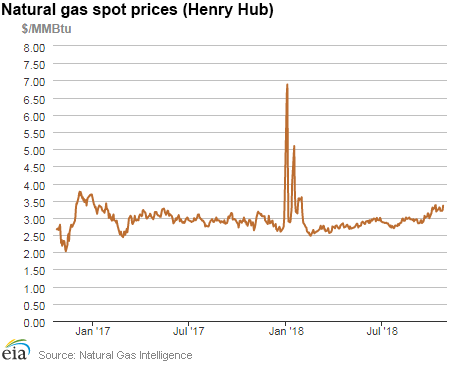
| Spot Prices ($/MMBtu) | Thu, 18-Oct |
Fri, 19-Oct |
Mon, 22-Oct |
Tue, 23-Oct |
Wed, 24-Oct |
|---|---|---|---|---|---|
| Henry Hub |
3.28 |
3.21 |
3.21 |
3.23 |
3.36 |
| New York |
2.98 |
3.11 |
3.23 |
3.35 |
3.49 |
| Chicago |
3.30 |
3.33 |
3.43 |
3.49 |
3.53 |
| Cal. Comp. Avg.* |
3.45 |
3.37 |
3.56 |
3.79 |
3.79 |
| Futures ($/MMBtu) | |||||
| November contract | 3.198 |
3.250 |
3.138 |
3.212 |
3.166 |
| December contract |
3.250 |
3.309 |
3.214 |
3.283 |
3.227 |
| *Avg. of NGI's reported prices for: Malin, PG&E Citygate, and Southern California Border Avg. | |||||
| Sources: Natural Gas Intelligence and CME Group as compiled by Bloomberg, L.P. | |||||
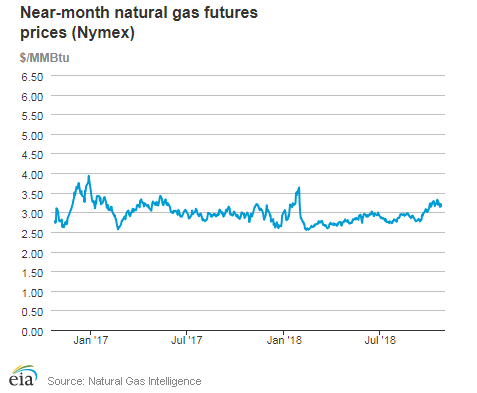
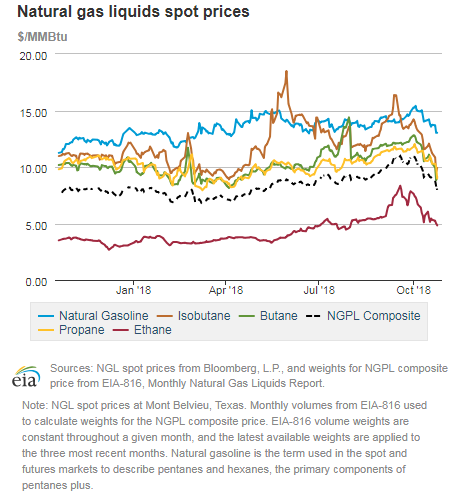
| U.S. natural gas supply - Gas Week: (10/18/18 - 10/24/18) | |||
|---|---|---|---|
Average daily values (Bcf/d): |
|||
this week |
last week |
last year |
|
| Marketed production | 97.2 |
96.1 |
84.0 |
| Dry production | 86.5 |
85.5 |
76.0 |
| Net Canada imports | 4.4 |
4.4 |
5.4 |
| LNG pipeline deliveries | 0.1 |
0.1 |
0.0 |
| Total supply | 91.0 |
90.0 |
81.5 |
|
Source: OPIS PointLogic Energy, an IHS Company | |||
| U.S. natural gas consumption - Gas Week: (10/18/18 - 10/24/18) | |||
|---|---|---|---|
Average daily values (Bcf/d): |
|||
this week |
last week |
last year |
|
| U.S. consumption | 68.5 |
67.7 |
58.9 |
| Power | 23.9 |
25.4 |
23.9 |
| Industrial | 22.4 |
22.0 |
21.6 |
| Residential/commercial | 22.2 |
20.3 |
13.5 |
| Mexico exports | 4.9 |
4.7 |
4.3 |
| Pipeline fuel use/losses | 7.5 |
7.4 |
6.5 |
| LNG pipeline receipts | 3.7 |
3.2 |
3.0 |
| Total demand | 84.6 |
83.0 |
72.7 |
|
Source: OPIS PointLogic Energy, an IHS Company | |||
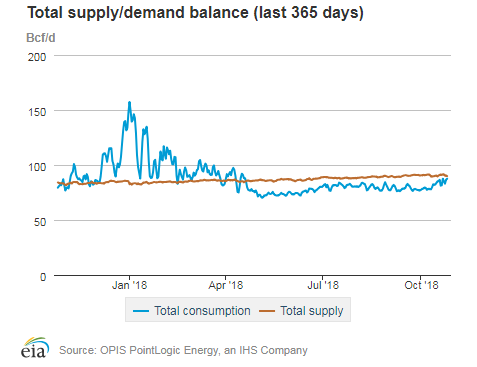
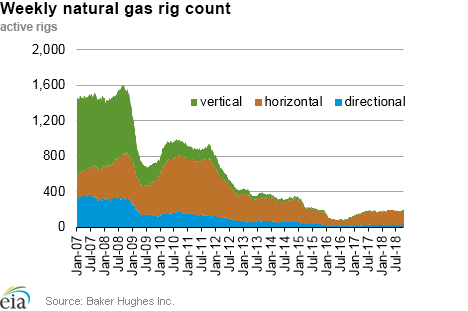
| Rigs | |||
|---|---|---|---|
Tue, October 16, 2018 |
Change from |
||
last week |
last year |
||
| Oil rigs | 873 |
0.5% |
18.6% |
| Natural gas rigs | 194 |
0.5% |
9.6% |
| Note: Excludes any miscellaneous rigs | |||
| Rig numbers by type | |||
|---|---|---|---|
Tue, October 16, 2018 |
Change from |
||
last week |
last year |
||
| Vertical | 69 |
4.5% |
11.3% |
| Horizontal | 926 |
-0.1% |
20.1% |
| Directional | 72 |
2.9% |
-10.0% |
| Source: Baker Hughes Inc. | |||
| Working gas in underground storage | ||||
|---|---|---|---|---|
Stocks billion cubic feet (Bcf) |
||||
| Region | 2018-10-19 |
2018-10-12 |
change |
|
| East | 825 |
812 |
13 |
|
| Midwest | 934 |
908 |
26 |
|
| Mountain | 177 |
177 |
0 |
|
| Pacific | 262 |
264 |
-2 |
|
| South Central | 896 C |
877 |
19 |
|
| Total | 3,095 C |
3,037 |
58 |
|
|
Source: Form EIA-912, "Weekly Underground Natural Gas Storage Report" C = Reclassification | ||||
| Working gas in underground storage | |||||
|---|---|---|---|---|---|
Historical comparisons |
|||||
Year ago (10/19/17) |
5-year average (2013-2017) |
||||
| Region | Stocks (Bcf) |
% change |
Stocks (Bcf) |
% change |
|
| East | 913 |
-9.6 |
903 |
-8.6 |
|
| Midwest | 1,078 |
-13.4 |
1,058 |
-11.7 |
|
| Mountain | 224 |
-21.0 |
215 |
-17.7 |
|
| Pacific | 315 |
-16.8 |
346 |
-24.3 |
|
| South Central | 1,171 |
-23.5 |
1,196 |
-25.1 |
|
| Total | 3,701 |
-16.4 |
3,719 |
-16.8 |
|
| Source: Form EIA-912, "Weekly Underground Natural Gas Storage Report" | |||||
| Temperature – heating & cooling degree days (week ending Oct 18) | ||||||||
|---|---|---|---|---|---|---|---|---|
HDD deviation from: |
CDD deviation from: |
|||||||
| Region | HDD Current |
normal |
last year |
CDD Current |
normal |
last year |
||
| New England | 112 |
12 |
43 |
0 |
0 |
0 |
||
| Middle Atlantic | 99 |
11 |
45 |
0 |
-1 |
-1 |
||
| E N Central | 145 |
52 |
90 |
0 |
-2 |
-2 |
||
| W N Central | 151 |
61 |
79 |
0 |
-2 |
-3 |
||
| South Atlantic | 40 |
-9 |
15 |
39 |
12 |
-5 |
||
| E S Central | 54 |
7 |
24 |
8 |
-4 |
-11 |
||
| W S Central | 46 |
29 |
30 |
21 |
-9 |
-24 |
||
| Mountain | 128 |
40 |
45 |
4 |
-8 |
-13 |
||
| Pacific | 21 |
-12 |
-1 |
0 |
-8 |
-14 |
||
| United States | 90 |
23 |
45 |
10 |
-2 |
-8 |
||
|
Note: HDD = heating degree day; CDD = cooling degree day Source: National Oceanic and Atmospheric Administration | ||||||||
Average temperature (°F)
7-Day Mean ending Oct 18, 2018
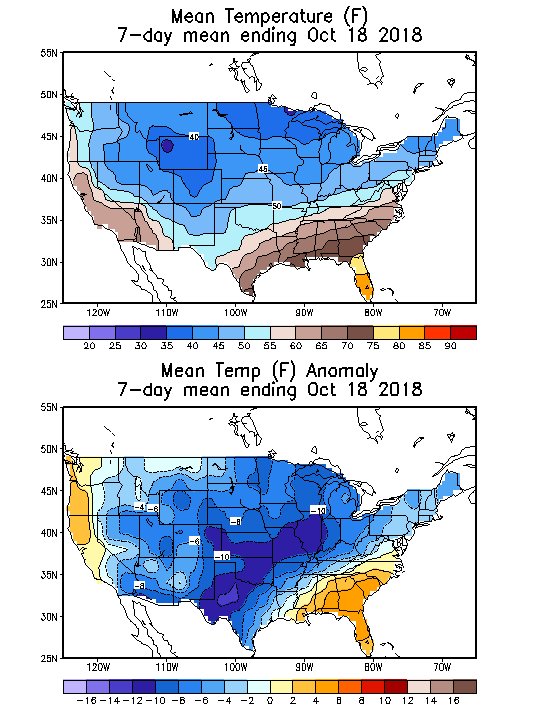
Source: NOAA National Weather Service
Deviation between average and normal (°F)
7-Day Mean ending Oct 18, 2018

Source: NOAA National Weather Service

